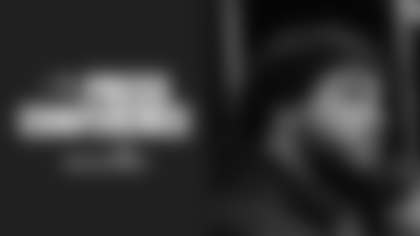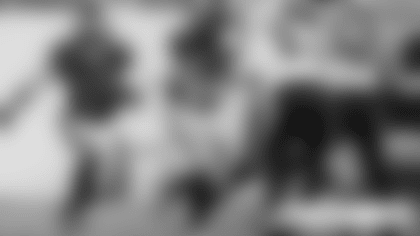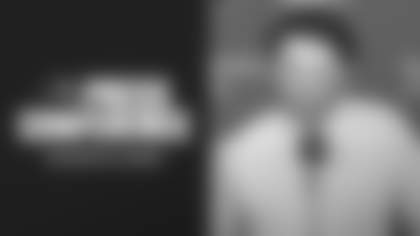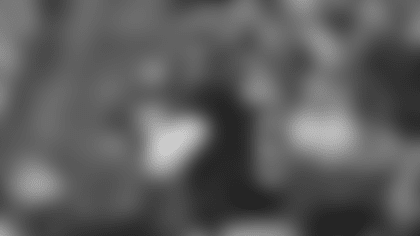RB Tony Hunt, here with Buccaneers Running Backs Coach Art Valero at the 2007 Senior Bowl, is ready to fill whatever role his NFL team needs
(More than 320 standout college players put their skills on display at the NFL Scouting Combine in late February. On the weekend of April 28-29, the vast majority of those players will hear their names called in the 2007 NFL Draft. During the months of March and April, Buccaneers.com will take a closer look at some of those names from the combine, and the stories behind them in our "Road to the Draft" series. These features are not meant to pinpoint the very top prospects in the draft, nor to reflect the Buccaneers' opinions or draft strategies. Any mention of draft-board status or a player's strengths and weaknesses are from outside sources, not the team's own scouting work. Currently featured: Penn State running back Tony Hunt.)
They only make 'em one way at Penn State.
That's Tony Hunt's perspective, at least. It's an informed perspective, to be sure, on the position of running back at his alma mater, given that he's the most recent person to hold that title.
Soon, Hunt could also be the most recent in a long line of Penn State backs to go early in the NFL Draft. He hopes he will be the next Nittany Lion to make an impact in the NFL, and he knows he fits the same profile that describes such predecessors as Larry Johnson and Curt Warner. That profile: "complete back."
"Going to Penn State, that's the kind of backs they demand," said Hunt. "We didn't hide ourselves back in pass-blocking, we did a lot of receiving out of the backfield. We worked on everything. We were expected to be able to do everything. It's not like we had certain backs to play in certain situations. I played the whole game. I had to be able to catch the ball, run the ball, block, protect the quarterback. I had to do everything."
Not that he's complaining. The every-down workload allowed Hunt, a workmanlike sort who goes about his business quietly and efficiently, to climb all the way to fifth on Penn State's all-time rushing list, one spot ahead of Johnson. Warner, the long-time Seattle Seahawks star, tops that list with 3,398 yards; Hunt finished with 3,162, Johnson with 2,953.
In the end, even Hunt was surprised to find himself that high on the list, statistically within the ranks of such recognizable names.
"It just happened," he said, claiming not to even know his own final totals. "I didn't really see it coming, it just happened. I just think it's an honor to be mentioned in the same category as those guys because they're all great backs."
Of course, the backs listed between Warner and Hunt on that list are recognizable to NFL fans, too, but not for a particularly cheerful reason. Ranked second through fourth on the Nittany Lions' rushing chart are Blair Thomas, Curtis Enis and D.J. Dozier, all first-round draft picks and all NFL busts. In addition, Ki-Jana Carter, who was drafted first overall in 1995, was a memorable miss for the Cincinnati Bengals.
Johnson, the 27th overall pick in 2003, looked like he could be headed in the same direction after he spent his first two seasons languishing behind Priest Holmes in Kansas City and gaining a reputation, deserved or not, as a malcontent. Johnson got his shot in 2005, however, and less than two years later is considered the best back in the NFL this side of LaDainian Tomlinson.
Johnson broke the string of Penn State busts between Warner and himself, and he even has a theory as to why his alma mater might be turning out stronger talents in the 2000s. According to Johnson, a more varied offense with a larger passing component produces a more complete prospect who is not just the product of a pound-away attack behind a behemoth line.
It certainly is worth noting that Hunt had strong receiving numbers to go with his 3,000 rushing yards. He caught 87 passes for 792 yards and three touchdowns, including a team-leading 39 receptions as a sophomore.
"My junior year I caught a lot of balls, senior year I caught a lot of balls, too," he said. "I split out at wideout and caught passes that way. I think I was given a lot of opportunities to show my hands out of the backfield."
In fact, the Nittany Lions even ran something of a spread attack early in his career before going back to more of a power attack. Though he and the team had more success with the second approach, Hunt actually enjoyed playing in the spread offense and thinks it could have been a big success with the stronger personnel the Lions featured in his last two seasons.
"I think it would have been interesting to see how our offense would have done with the team that we had the next year," he said. "I liked the spread a lot though. [Overall], I think it shows that I can play single-back, shotgun, I formation…it doesn't really matter to me."
That being said, the solidly-built, 6-1, 233-pound Hunt is well-suited for a grind-it-out approach, and he was used in that capacity quite a bit in 2006, as the Nittany Lions went 8-4 and earned a berth in the Outback Bowl at Raymond James Stadium. As much as the spread offense intrigued him, the power game satisfied his football passions at a baser level.
"I think we did that a lot this year, pound the ball out and get into the fourth quarter, and if we get a little lead, just run the ball, run the clock out and control the game," said Hunt. "I think when you can do that, it shows that you're just flat-out better than the other team. If you can run the ball and dominate them like that, it's more making a statement than just running the football."
Hunt, the son of a military man who moved his family from Texas to Hawaii to California to Virginia, was a true workhorse for Penn State last fall, accounting for 1,228 of the team's 1,767 rushing yards and 26 of its 212 receptions. He touched the ball on carries and receptions 710 times over his four seasons with the team, and wouldn't have had it any other way. However, he understands that his position is a rugged one, often with a shortened career arc, and he thinks the NFL is therefore trending towards having multiple feature backs per team. Of course, that's a positive for Hunt if true, in that it increases the number of teams that should be interested in his services.
"Running back is one of those positions that's so rough you have to have more than one back," he said. "A back can get hurt any play, any moment. You have to have a capable back able to come in and play. I think it's noticeable. Every team will have a top back and still come out and draft a back, maybe even in the first round. You can't just rely on one back, it's such a rough position."
That, of course, is exactly what the Chiefs did when they drafted Johnson while Holmes was still putting up enormous numbers. Johnson, in fact, got his extended chance in 2005 when Holmes got hurt. Hunt isn't trying to compare himself to Johnson – "I think his game is like nobody else's," is Hunt's specific quote – but he does believe he could make any NFL team happy.
"I think I would give a team a complete back, somebody who could fit in any situation," he said. "I can run the ball, I can catch and I can block. If you want a big back, a complete back, I feel like I can fill that need."






















